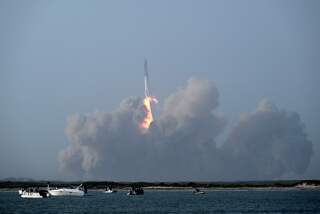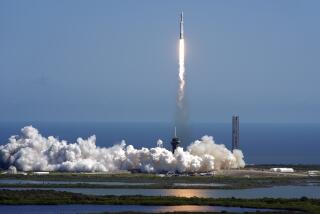SpaceX reaches milestone in rocket launch from Cape Canaveral
With a thunderous roar, a 224-foot rocket carrying a massive satellite launched from Cape Canaveral and blasted into outer space, hurtling over the Atlantic Ocean as it cut across the night sky.
On Tuesday, Hawthorne rocket maker SpaceX lifted the SES-8 telecommunications satellite into geostationary transfer orbit -- nearly 50,000 miles from Earth. It was the first time the company reached such a distance, which is about one-quarter of the way to the moon.
Before the launch attempt, SpaceX said it would be the most challenging mission to date, and technical issues cropped up early.
The company, officially named Space Exploration Technologies Corp., had originally planned on launching the rocket Nov. 25 but technical issues postponed it. SpaceX tried again Thanksgiving Day, but computers shut down the attempt after sensing an issue in the rocket’s nine engines.
But the third time proved to be a charm for the upstart company in its 5:41 p.m. EST launch of an upgraded version of its Falcon 9 rocket.
SpaceX had launched a smaller version of the rocket six times in test missions and three flights to the International Space Station. The company has a $1.6-billion contract with NASA to make a dozen unmanned missions to restock the orbiting laboratory.
The upgraded rocket, dubbed Falcon 9 Version 1.1, is larger, with more powerful engines. The company first launched it from Vandenberg Air Force Base, about 150 miles northwest of Los Angeles, in September.
In Tuesday’s launch, the Falcon 9 lifted a telecommunications satellite weighing about 7,000 pounds. It was built by Orbital Sciences Corp. It’s set to provide signals to television and broadband for telecommunication company SES’ customers in Asia.
The launch was a big step for SpaceX and its chief executive, Elon Musk. In starting SpaceX in 2002, his goal was to make money by developing and launching rockets that could carry satellites into space at a fraction of the cost of the current generation of spacecraft.
Now that SpaceX has proven it can place a bigger satellite into higher orbit, Musk’s sales pitch will appeal to potential customers in the commercial and military launch markets, which has long been dominated by entrenched aerospace firms.
SpaceX is eager to break into the Evolved Expendable Launch Vehicle program -- the lucrative business of launching national security satellites for the U.S. government.
United Launch Alliance, a joint venture of aerospace giants Lockheed Martin Corp. and Boeing Co., is currently the Pentagon’s sole launch provider for such missions.
This launch marks the second of three flights needed to certify the Falcon 9.
ALSO:
AeroVironment earnings drop 80%
Amazon hopes drone delivery idea will fly
FAA to issue warning on engine icing risks on 787s and 747s
More to Read
Inside the business of entertainment
The Wide Shot brings you news, analysis and insights on everything from streaming wars to production — and what it all means for the future.
You may occasionally receive promotional content from the Los Angeles Times.











